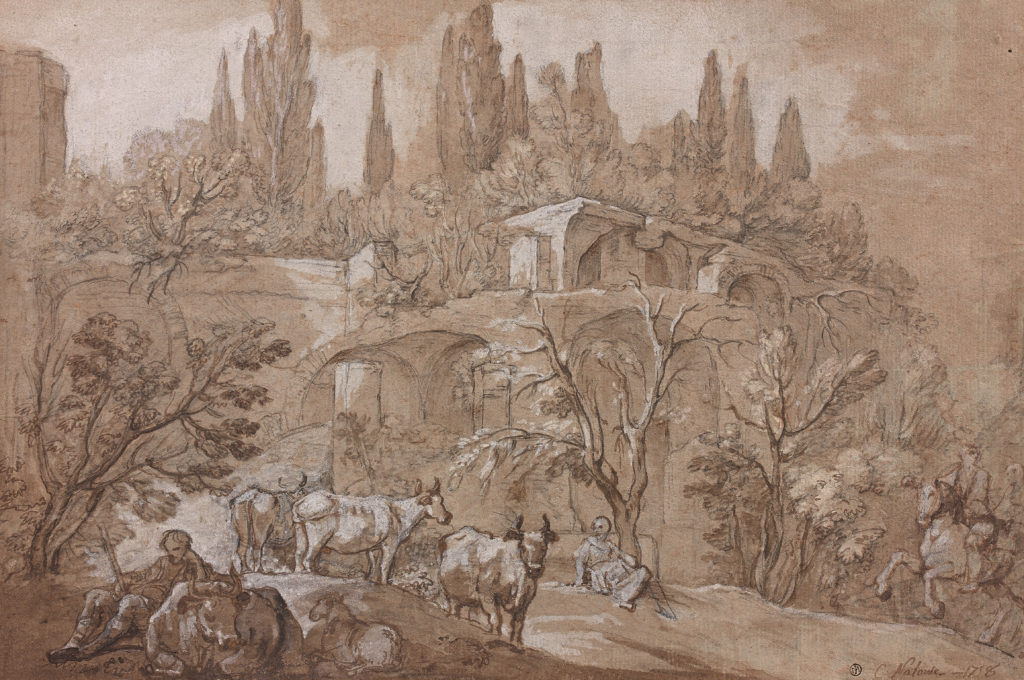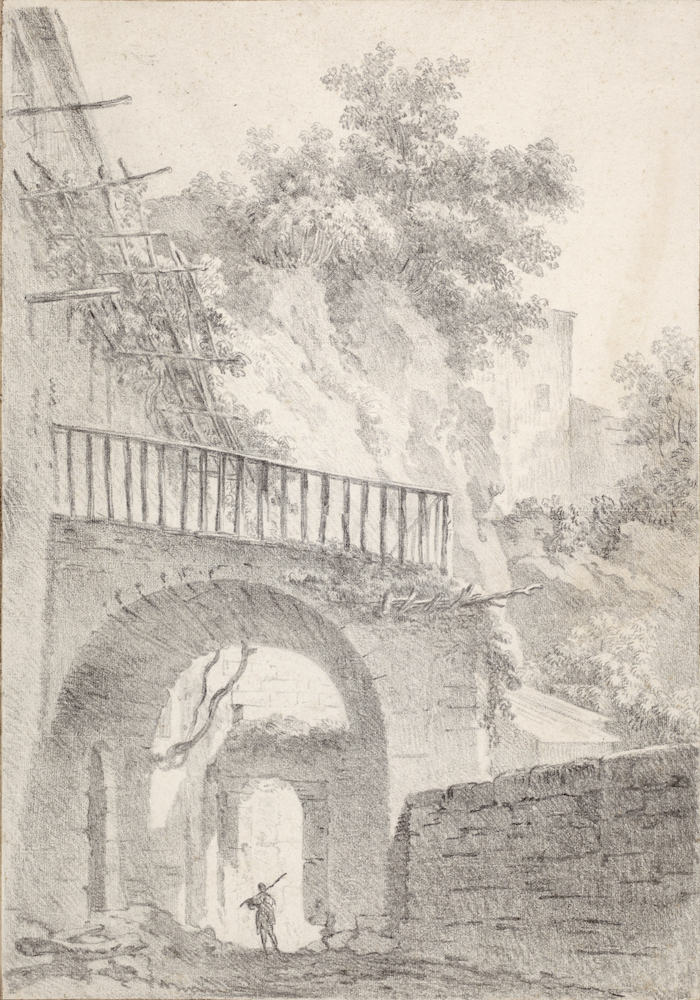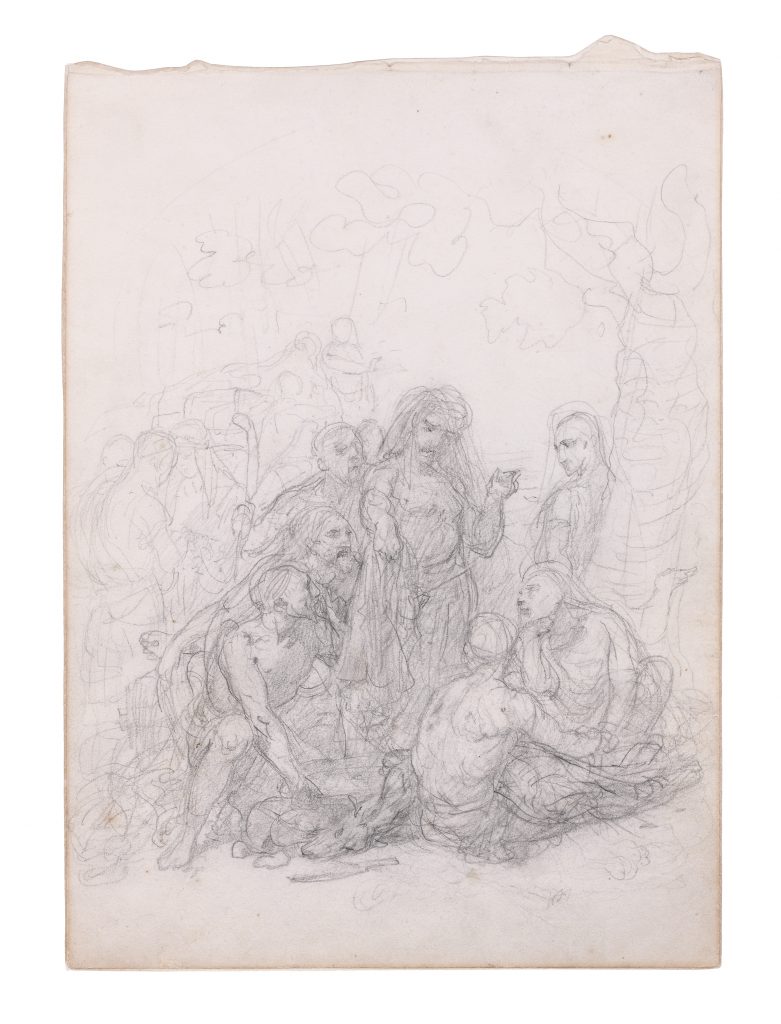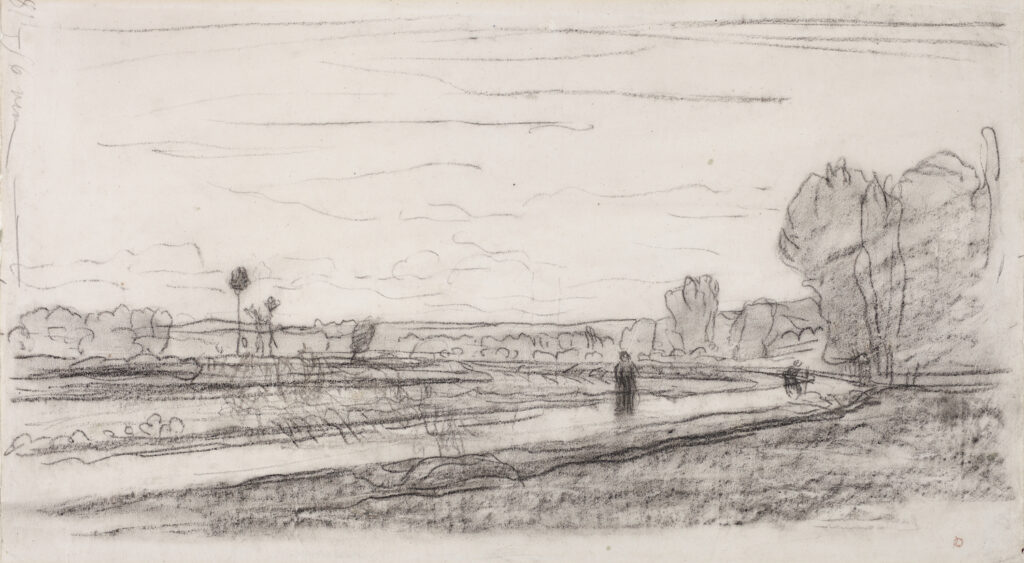
Jérôme François Chantereau (1710 - 1757)
Study of a Standing Soldier
Black and red chalk
251 x 122 mm (9 7/8 x 4 6/8 in.)
Inscription in pen and brown ink lower right: Le nain f.
Inscription in pen and brown ink on the verso, top center: noir sur papier bistré
Long considered a minor master working in the style of Watteau, Jérôme-François Chantereau is today appreciated due to about forty drawings given to him. The National Museum of Stockholm and the Musée du Louvre each hold a dozen sheets by Chantereau. The artist’s drawings are characterized by the use of the technique of red and black chalk with the occasional addition of white chalk, and stumping to soften the contours, as well as pastel. He seems to have preferred subjects from daily life as most of his figure drawings depict peasants, soldiers, and beggars.
251 x 122 mm (9 7/8 x 4 6/8 in.)
Inscription in pen and brown ink lower right: Le nain f.
Inscription in pen and brown ink on the verso, top center: noir sur papier bistré
Long considered a minor master working in the style of Watteau, Jérôme-François Chantereau is today appreciated due to about forty drawings given to him. The National Museum of Stockholm and the Musée du Louvre each hold a dozen sheets by Chantereau. The artist’s drawings are characterized by the use of the technique of red and black chalk with the occasional addition of white chalk, and stumping to soften the contours, as well as pastel. He seems to have preferred subjects from daily life as most of his figure drawings depict peasants, soldiers, and beggars.

Charles Joseph Natoire (1700 - 1777)
Landscape with Ruins, Figures, and Animals
Black chalk, pen and brown ink, brown wash, white highlights on blue paper
236 x 355 mm
Inscribed in pen and brown ink lower right: C. Natoire 1758
Provenance:
Jean Masson (L.1494a); its first sale in Paris May 7-8, 1923, lot 157;
Sale Versailles 3 February 1963;
Solange and Georges Delauney;
Jean-Claude Delauney
Bibliography:
S. Boyer, Catalogue raisonné de l’œuvre de Charles Natoire, peintre du roi, Archive de l’Art Français, Vol. XXI, 1949, p. 31 - 107, n ° 645
S. Caviglia-Brunel, Charles-Joseph Natoire, Arthena 2012, p.181, n ° D36
236 x 355 mm
Inscribed in pen and brown ink lower right: C. Natoire 1758
Provenance:
Jean Masson (L.1494a); its first sale in Paris May 7-8, 1923, lot 157;
Sale Versailles 3 February 1963;
Solange and Georges Delauney;
Jean-Claude Delauney
Bibliography:
S. Boyer, Catalogue raisonné de l’œuvre de Charles Natoire, peintre du roi, Archive de l’Art Français, Vol. XXI, 1949, p. 31 - 107, n ° 645
S. Caviglia-Brunel, Charles-Joseph Natoire, Arthena 2012, p.181, n ° D36

Joseph-François-Pierre-Ignace Parrocel (1704-1781)
Three Woman Bathing (Diana and Callisto?)
black chalk, white chalk on a blue/grey paper
304 x 373 mm
304 x 373 mm

Augustin de Saint-Aubin (1736-1807)
Two Young Women at their Toilet
Black chalk
179 x 90 mm, 7 1/16 x 3 9/16 in.
Provenance:
Private collection, France
The present sheet is part of a set of drawings by Augustin de Saint-Aubin depicting women in their intimate world. These drawings seem to come from a single sketchbook, most likely executed between 1780 and 1785. Some sheets are annotated with the name and address of the model, and some with remarks on the models themselves. Among the other known drawings from this sketchbook, we can mention the seven sheets sold at Sotheby's, 20 August 1967, lots 162 - 168, two of which are today in the Nationalmuseum in Stockholm (inv. N° NM275/1968, inv. n° 276/1968); a sketch in the Fitzwilliam Museum in Cambridge (inv. n° PD102-1961); and a drawing of a Woman Holding a Book, in the Fine Arts Museum in San Francisco (inv. n° 1967.17.112).
179 x 90 mm, 7 1/16 x 3 9/16 in.
Provenance:
Private collection, France
The present sheet is part of a set of drawings by Augustin de Saint-Aubin depicting women in their intimate world. These drawings seem to come from a single sketchbook, most likely executed between 1780 and 1785. Some sheets are annotated with the name and address of the model, and some with remarks on the models themselves. Among the other known drawings from this sketchbook, we can mention the seven sheets sold at Sotheby's, 20 August 1967, lots 162 - 168, two of which are today in the Nationalmuseum in Stockholm (inv. N° NM275/1968, inv. n° 276/1968); a sketch in the Fitzwilliam Museum in Cambridge (inv. n° PD102-1961); and a drawing of a Woman Holding a Book, in the Fine Arts Museum in San Francisco (inv. n° 1967.17.112).

Louis Rolland Trinquesse (1746-1800)
Naked Woman Lying on a Cloud
Red chalk
445 x 595 mm
Provenance:
Private collection, Paris
Trinquesse is known for his red chalk drawings depicting elegant women busy in their daily activities. Drawings of nude figures by Trinquesse are rare. Those that do exist can be divided into two groups: those executed in black chalk, and those executed in red chalk, to which the present drawing belongs. By comparison, we can mention the Academy of a Man today at the École des Beaux-Arts in Paris: the body is outlined by a strong line and the shadows cast by a regular series of parallel lines.
As women were not allowed to pose at the Academy in the 18th century, this study was most likely done in Trinquesse's own studio. The artist probably knew the young woman intimately to have her pose in such a daring and exuberant way. Another drawing by Trinquesse, Naked Woman Sitting Reading, features the same young woman in a similar atmosphere. Trinquesse also produced a print with a similar sensuality entitled La Sortie du bain, today in the British Museum.
445 x 595 mm
Provenance:
Private collection, Paris
Trinquesse is known for his red chalk drawings depicting elegant women busy in their daily activities. Drawings of nude figures by Trinquesse are rare. Those that do exist can be divided into two groups: those executed in black chalk, and those executed in red chalk, to which the present drawing belongs. By comparison, we can mention the Academy of a Man today at the École des Beaux-Arts in Paris: the body is outlined by a strong line and the shadows cast by a regular series of parallel lines.
As women were not allowed to pose at the Academy in the 18th century, this study was most likely done in Trinquesse's own studio. The artist probably knew the young woman intimately to have her pose in such a daring and exuberant way. Another drawing by Trinquesse, Naked Woman Sitting Reading, features the same young woman in a similar atmosphere. Trinquesse also produced a print with a similar sensuality entitled La Sortie du bain, today in the British Museum.

Louis Chaÿs or Chaix (1740-1810)
A Man Walking under the Arcades at Cotignac
Counter-proof in black chalk
466 x 325 mm
Inscription in pen and brown ink lower left on the mount: L. chaix f. 1781
Watermark: Lily flower in a double circle
Provenance:
Alfred Normand (L.153c)
Painter and draftsman originally from Aubagne, Louis Chaix divided his career between Marseille and Paris. Thanks to his patron Joseph Borely, Chaix stayed in Italy from 1771 to 1777. There he met the residents of the Académie de France with whom he often drew outside, from life. Chaix thus executed large landscape drawings in Rome in black chalk and sometimes in red chalk, which today testify to his interest in ancient monuments in ruins. Chaix continued to draw landscapes after his return to France, as shown here by our counter-proof representing the old arcades in Cotignac. The original drawing that was used in the execution of this counter-proof is known from a photograph but its present location is unknown (see gallery documentation).
466 x 325 mm
Inscription in pen and brown ink lower left on the mount: L. chaix f. 1781
Watermark: Lily flower in a double circle
Provenance:
Alfred Normand (L.153c)
Painter and draftsman originally from Aubagne, Louis Chaix divided his career between Marseille and Paris. Thanks to his patron Joseph Borely, Chaix stayed in Italy from 1771 to 1777. There he met the residents of the Académie de France with whom he often drew outside, from life. Chaix thus executed large landscape drawings in Rome in black chalk and sometimes in red chalk, which today testify to his interest in ancient monuments in ruins. Chaix continued to draw landscapes after his return to France, as shown here by our counter-proof representing the old arcades in Cotignac. The original drawing that was used in the execution of this counter-proof is known from a photograph but its present location is unknown (see gallery documentation).

Théodore Géricault (1791 - 1824)
Cavalry Fight: Combat between Hussars and Mameluks during the Egyptian Campaign
Watercolor, pen and brown ink, graphite
131 x 163 mm (5 1/8 x 6 3/8 in.)
Provenance: Private collection, France
Bibliography:
Bruno Chenique, Citoyens du Monde. Noirs et Orientaux de Géricault, Paris, 2020, p. 228, fig. 127, illus.
The present drawing of a Cavalry Fight: Combat between Hussars and Mameluks during the Egyptian Campaign by Géricault is a recent discovery and exciting addition to the artist’s drawn oeuvre. During his career, the artist tackled several times the subject of the Egyptian campaign, a military expedition led by General Bonaparte between 1798 and 1801 in order to seize this country.
The present drawing was executed around 1822-1823, just after Géricault’s return from London. Forced into bed rest due to sciatica, the artist painted numerous watercolors during his recovery. As Germain Bazin wrote: "The most important and probably the best production of Géricault in this last period are his watercolors. These watercolors are admirable; […] his watercolor becomes clear, and displays remarkable purity. This is probably what he gained from his contact with the English School.“
131 x 163 mm (5 1/8 x 6 3/8 in.)
Provenance: Private collection, France
Bibliography:
Bruno Chenique, Citoyens du Monde. Noirs et Orientaux de Géricault, Paris, 2020, p. 228, fig. 127, illus.
The present drawing of a Cavalry Fight: Combat between Hussars and Mameluks during the Egyptian Campaign by Géricault is a recent discovery and exciting addition to the artist’s drawn oeuvre. During his career, the artist tackled several times the subject of the Egyptian campaign, a military expedition led by General Bonaparte between 1798 and 1801 in order to seize this country.
The present drawing was executed around 1822-1823, just after Géricault’s return from London. Forced into bed rest due to sciatica, the artist painted numerous watercolors during his recovery. As Germain Bazin wrote: "The most important and probably the best production of Géricault in this last period are his watercolors. These watercolors are admirable; […] his watercolor becomes clear, and displays remarkable purity. This is probably what he gained from his contact with the English School.“

Emile Jean Horace Vernet (1789 - 1863)
Joseph's Coat
Graphite
verso: Studies of a Jacket, the Bust of a Man with Outstretched Arms, and the Lower Body of a Man seen from Behind
Graphite
360 x 260 mm (14 1/4 x 10 1/8 in.)
Provenance: In the estate of Horace Vernet until the sale in Paris, Hôtel Drouot, Etude Couturier Nicolay, 27 April 1994, lot 139
The present drawing by Vernet is preparatory for the artist’s painting Joseph’s Coat, today in the Wallace Collection in London. The subject is drawn in a loose, searching manner, in which Vernet’s hand seems to be finding the forms of the figures as they emerge from the blur of pencil lines.
The story of Joseph’s Coat is from the Old Testament (Genesis 27:26-33). Joseph, the favorite son of Jacob, had been sold by his brothers to Midianite merchants. They smeared his coat with the blood of a kid and returned it to their father as evidence of Joseph’s death. In the drawing, Judah stands in the center holding Joseph’s coat drenched in blood.
verso: Studies of a Jacket, the Bust of a Man with Outstretched Arms, and the Lower Body of a Man seen from Behind
Graphite
360 x 260 mm (14 1/4 x 10 1/8 in.)
Provenance: In the estate of Horace Vernet until the sale in Paris, Hôtel Drouot, Etude Couturier Nicolay, 27 April 1994, lot 139
The present drawing by Vernet is preparatory for the artist’s painting Joseph’s Coat, today in the Wallace Collection in London. The subject is drawn in a loose, searching manner, in which Vernet’s hand seems to be finding the forms of the figures as they emerge from the blur of pencil lines.
The story of Joseph’s Coat is from the Old Testament (Genesis 27:26-33). Joseph, the favorite son of Jacob, had been sold by his brothers to Midianite merchants. They smeared his coat with the blood of a kid and returned it to their father as evidence of Joseph’s death. In the drawing, Judah stands in the center holding Joseph’s coat drenched in blood.

Pierre Luc Charles Cicéri (1782-1868)
Project for an Opera Set
Watercolor on pencil
248 x 344 mm, 9 ¾ x 13 9/16 in.
Provenance:
Appleby Brothers, London;
Private collection, Scotland;
Private collection, USA
Pierre Luc Charles Cicéri was undoubtedly the greatest painter of opera sets and theater scenes active in France in the first half of the nineteenth century. His talent enabled him to become chief decorator of the Paris Opera in 1818, a position he held for thirty-two years. The artist created more than 300 opera sets during his career. His collaboration with Louis-Jacques Daguerre, particularly ingenious in the use of diorama and cyclorama, brought dazzling creativity to his stage design. Our drawing is preparatory for the set of the opera Les Martyrs presented in 1840. Other known set projects for this opera include similar decorative elements. The movement, ardor, and expressiveness of the design testify to Cicéri's stylistic maturity.
248 x 344 mm, 9 ¾ x 13 9/16 in.
Provenance:
Appleby Brothers, London;
Private collection, Scotland;
Private collection, USA
Pierre Luc Charles Cicéri was undoubtedly the greatest painter of opera sets and theater scenes active in France in the first half of the nineteenth century. His talent enabled him to become chief decorator of the Paris Opera in 1818, a position he held for thirty-two years. The artist created more than 300 opera sets during his career. His collaboration with Louis-Jacques Daguerre, particularly ingenious in the use of diorama and cyclorama, brought dazzling creativity to his stage design. Our drawing is preparatory for the set of the opera Les Martyrs presented in 1840. Other known set projects for this opera include similar decorative elements. The movement, ardor, and expressiveness of the design testify to Cicéri's stylistic maturity.

Alexandre Gabriel Decamps (1803 - 1860)
Death and the Woodman
Charcoal, white chalk, pink pencil
247 x 196 mm, 9¾ x 7¾ inch.
Signed lower left: DECAMPS
Provenance : Private collection, Paris
Decamps was admired for the technical execution of his paintings and drawings, mixing different mediums in an innovative and sophisticated way. He would work the same subject several times using different techniques; in the 19th century, they talked about Les cuisines de M. Decamps. The theme of Death and the Woodsman was directly taken from Jean de la Fontaine’s fable: a woodsman, exhausted by his hard life and work, calls Death to deliver him from his suffering.
247 x 196 mm, 9¾ x 7¾ inch.
Signed lower left: DECAMPS
Provenance : Private collection, Paris
Decamps was admired for the technical execution of his paintings and drawings, mixing different mediums in an innovative and sophisticated way. He would work the same subject several times using different techniques; in the 19th century, they talked about Les cuisines de M. Decamps. The theme of Death and the Woodsman was directly taken from Jean de la Fontaine’s fable: a woodsman, exhausted by his hard life and work, calls Death to deliver him from his suffering.

Jean-François Millet (1814 - 1875)
Hagar
Charcoal on blue paper, squared in black chalk
220 x 435 mm; 811/16 x 171/8 in.
Verso: An Art Dealer Visiting a Painter, his Family Visible in the Background; a Separate Study of a Mother and her Children before a Wagon with Driver
Charcoal
Provenance: Anonymous sale, Paris, Binoche Renaud-Giquello & Associés, 30 March 2012, n°37, illus.; Collection Aristophile
The present drawing is preparatory for the figure of Hagar painted by Millet in his painting Hagar and Ishmael in the Mesdag museum in The Hague. Commissioned in 1848 by the French government, the painting was never finished, possibly because of Millet's departure for Barbizon.
. The subject is from the book of Genesis. Driven into the desert by Abraham after her mistress Sarah had given birth, Hagar finds herself alone in the wilderness with her son Ishmael. Millet chose to depict the most tragic moment in the story, when Hagar turns away from her child, unable to bear the pain of seeing him starve to death. In the drawing, as in the painting, the attention paid to the expression helps to convey the very essence of the story, which is human suffering. Executed in black charcoal, the figure of Hagar, ugly, hollow and distorted, manifests her despair. Millet's realism here prefigures the work of 20th century artists like Käthe Kollwitz.
220 x 435 mm; 811/16 x 171/8 in.
Verso: An Art Dealer Visiting a Painter, his Family Visible in the Background; a Separate Study of a Mother and her Children before a Wagon with Driver
Charcoal
Provenance: Anonymous sale, Paris, Binoche Renaud-Giquello & Associés, 30 March 2012, n°37, illus.; Collection Aristophile
The present drawing is preparatory for the figure of Hagar painted by Millet in his painting Hagar and Ishmael in the Mesdag museum in The Hague. Commissioned in 1848 by the French government, the painting was never finished, possibly because of Millet's departure for Barbizon.
. The subject is from the book of Genesis. Driven into the desert by Abraham after her mistress Sarah had given birth, Hagar finds herself alone in the wilderness with her son Ishmael. Millet chose to depict the most tragic moment in the story, when Hagar turns away from her child, unable to bear the pain of seeing him starve to death. In the drawing, as in the painting, the attention paid to the expression helps to convey the very essence of the story, which is human suffering. Executed in black charcoal, the figure of Hagar, ugly, hollow and distorted, manifests her despair. Millet's realism here prefigures the work of 20th century artists like Käthe Kollwitz.

Charles François Daubigny (1817-1878)
Chemin de Halage, les Bords de l’Oise
charcoal
354 x 640 mm, 13 15/16 x 25 3/16
Stamped with Daubigny estate mark in red ink lower right (L. 518)
The present large drawing is preparatory for the painting Chemin de Halage, Les Bords de l’Oise today in the Museum Mesdag, The Hague . The painting is dated around 1875 and the drawing might have been executed at the same time. Daubigny treated the river Oise many times throughout his career, continually returning to its waters and barks in search of motifs. In 1857 he traveled the river in the boat of Jules Breton, mooring wherever he found his subjects. The present work, in which we see the landscape from the bank of the river, appears to be a kind of study in atmospheric perspective. The drawing focuses on the forms of the trees and the road receding into the distance. The horses clearly visible in the painting are hinted at only in a rapid shorthand notation; the barge is just recognizable by the faint vertical lines indicating a mast. The vigorous but loose handling of the charcoal gives graphic life to the calm scene.
354 x 640 mm, 13 15/16 x 25 3/16
Stamped with Daubigny estate mark in red ink lower right (L. 518)
The present large drawing is preparatory for the painting Chemin de Halage, Les Bords de l’Oise today in the Museum Mesdag, The Hague . The painting is dated around 1875 and the drawing might have been executed at the same time. Daubigny treated the river Oise many times throughout his career, continually returning to its waters and barks in search of motifs. In 1857 he traveled the river in the boat of Jules Breton, mooring wherever he found his subjects. The present work, in which we see the landscape from the bank of the river, appears to be a kind of study in atmospheric perspective. The drawing focuses on the forms of the trees and the road receding into the distance. The horses clearly visible in the painting are hinted at only in a rapid shorthand notation; the barge is just recognizable by the faint vertical lines indicating a mast. The vigorous but loose handling of the charcoal gives graphic life to the calm scene.